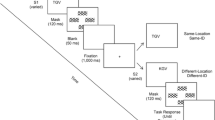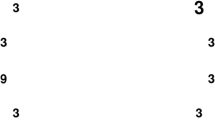Abstract
In four experiments in which participants searched for multiple target digits we hypothesized that search should be fastest when the targets are arranged closely together on the number line without any intervening distractor digits, i.e., the targets form a contiguous and coherent group. In Experiment 1 search performance was better for targets defined by numerical magnitude than parity (i.e., evenness); this result supports our hypothesis but could also be due to the linear separability of targets from distractors or the numerical distance between them. Experiment 2 controlled for target-distractor linear separability and numerical distance, yielding faster search when targets were surrounded by distractors on the number line than when they surrounded distractors. This result is consistent with target contiguity and coherence but also with grouping by similarity of target shapes. Experiment 3 controlled for all three alternative explanations (linear separability, numerical distance, and shape similarity) and search performance was better for contiguous targets than separated targets. In Experiment 4 search performance was better for a coherent target group than one with intervening distractors. Of the possibilities we considered, only the hypothesis based on the contiguity and coherence of the target group on the number line can account for the results from all four experiments.





Similar content being viewed by others
References
Anderson, D. E., Vogel, E. K., & Awh, E. (2013). A common discrete resource for visual working memory and visual search. Psychological Science, 24, 929–938. doi:10.1177/0956797612464380
Bauer, B., Jolicoeur, P., & Cowan, W. B. (1996a). Distractor heterogeneity versus linear separability in colour visual search. Perception, 25, 1281–1294. doi:10.1068/p251281
Bauer, B., Jolicoeur, P., & Cowan, W. B. (1996b). Visual search for colour targets that are or are not linearly separable from distractors. Vision Research, 36, 1439–1465. doi:10.1016/0042-6989(95)00207-3
Bauer, B., Jolicoeur, P., & Cowan, W. B. (1998). The linear separability effect in color visual search: Ruling out the additive color hypothesis. Perception & Psychophysics, 60, 1083–1093. doi:10.3758/BF03211941
Bausell, R. B., & Li, Y.-F. (2002). Power Analysis for Experimental Research: A Practical Guide for the Biological, Medical, and Social Sciences. Cambridge: Cambridge University Press.
Beck, V. M., Hollingworth, A., & Luck, S. J. (2011). Simultaneous control of attention by multiple working memory representations. Psychological Science, 23, 887–898. doi:10.1177/0956797612439068
Cohen, D. J. (2009). Integers do not automatically activate their quantity representation. Psychonomic Bulletin & Review, 16, 332–336. doi:10.3758/PBR.16.2.332
D’Zmura, M. (1991). Color in visual search. Vision Research, 31, 951–966. doi:10.1016/0042-6989(91)90203-H
Duncan, J., & Humphreys, G. W. (1989). Visual search and stimulus similarity. Psychological Review, 96, 433–458. doi:10.1037/0033-295X.96.3.433
Feigenson, L., Dehaene, S., & Spelke, E. (2004). Core systems of number. Trends in Cognitive Sciences, 8, 307–314. doi:10.1016/j.tics.2004.05.002
Firestone, C., & Scholl, B. J. (2014). “Top-down” effects where none should be found: The El Greco fallacy in perception research. Psychological Science, 25, 38–46. doi:10.1177/0956797613485092
García-Orza, J., Perea, M., Mallouh, R. A., & Carreiras, M. (2012). Physical similarity (and not quantity representation) drives perceptual comparison of numbers: Evidence from two Indian notations. Psychonomic Bulletin & Review, 19, 294–300. doi:10.3758/s13423-011-0212-8
Godwin, H. J., Hout, M. C., & Menneer, T. (2014). Visual similarity is stronger than semantic similarity in guiding visual search for numbers. Psychonomic Bulletin & Review, 21, 689–695. doi:10.3758/s13423-013-0547-4
Goldfarb, L., Henik, A., Rubinsten, O., Block-David, Y., & Gertner, L. (2011). The numerical distance effect is task dependent. Memory & Cognition, 39, 1508–1517. doi:10.3758/s13421-011-0122-z
Krueger, L. E. (1984). The category effect in visual search depends on physical rather than conceptual differences. Perception & Psychophysics, 35, 558–564. doi:10.3758/BF03205953
Lupyan, G. (2008). The conceptual grouping effect: Categories matter (and named categories matter more). Cognition, 108, 566–577. doi:10.1016/j.cognition.2008.03.009
Lupyan, G., & Spivey, M. J. (2008). Perceptual processing is facilitated by ascribing meaning to novel stimuli. Current Biology, 18, R410–R412. doi:10.1016/j.cub.2008.02.073
Lupyan, G., & Ward, E. J. (2013). Language can boost otherwise unseen objects into visual awareness. Proceedings of the National Academy of Sciences of the United States of America, 110, 14196–14201. doi:10.1073/pnas.1303312110
Menneer, T., Cave, K. R., & Donnelly, N. (2009). The cost of search for multiple targets: Effects of practice and target similarity. Journal of Experimental Psychology: Applied, 15, 125–139. doi:10.1037/a0015331
Meteyard, L., Bahrami, B., & Vigliocco, G. (2007). Motion detection and motion words: Language affects low-level visual perception. Psychological Science, 18, 1007–1013. doi:10.1111/j.1467-9280.2007.02016.x
Moyer, R. S., & Landauer, T. K. (1967). Time required for judgments of numerical equality judgments. Bulletin of the Psychonomic Society, 1, 167–168. doi:10.1038/2151519a0
Müller-Lyer, F. C. (1889). Optische Urteilstäuschungen. Archiv für Physiologie, 263–270.
Olivers, C. N., Peters, J., Houtkamp, R., & Roelfsema, P. R. (2011). Different states in visual working memory: When it guides attention and when it does not. Trends in Cognitive Science, 15, 327–334. doi:10.1016/j.tics.2011.05.004
Pinhas, M., Pothos, E. M., & Tzelgov, J. (2013). Zooming in and out from the mental number line: Evidence for a number range effect. Journal of Experimental Psychology: Learning, Memory, & Cognition, 39, 972–976. doi:10.1037/a0029527
Poole, B. J., & Kane, M. J. (2009). Working-memory capacity predicts the executive control of visual search among distractors: The influences of sustained and selective attention. Quarterly Journal of Experimental Psychology, 62, 1430–1454. doi:10.1080/17470210802479329
Proulx, M. J., & Egeth, H. E. (2006). Target-nontarget similarity modulates stimulus-driven control in visual search. Psychonomic Bulletin & Review, 13, 524–529. doi:10.1007/s00426-006-0077-z
Puri, A. M., & Wojciulik, E. (2008). Expectation both helps and hinders object perception. Vision Research, 48, 589–597. doi:10.1016/j.visres.2007.11.017
Pylyshyn, Z. (1999). Is vision continuous with cognition? The case for cognitive impenetrability of visual perception. Behavioral and Brain Sciences, 22, 341–365. doi:10.1017/S0140525X99002022
Reijnen, E., Wolfe, J. M., & Krummenacher, J. (2013). Coarse guidance by numerosity in visual search. Attention, Perception, & Psychophysics, 75, 16–28. doi:10.3758/s1314-012-0379-8
Schwarz, W., & Eiselt, A. K. (2012). Numerical distance effects in visual search. Attention, Perception, & Psychophysics, 74, 1098–1103. doi:10.3758/s1314-012-0342-8
Sobel, K. V., Gerrie, M. P., Poole, B. J., & Kane, M. J. (2007). Individual differences in working memory capacity and visual search: The roles of top-down and bottom-up processing. Psychonomic Bulletin & Review, 14, 840–845. doi:10.3758/BF03194109
Stroop, J. R. (1935). Studies in interference in serial verbal reactions. Journal of Experimental Psychology, 18, 643–661. doi:10.1037/h0054651
Stroud, M. J., Menneer, T., Cave, K. R., & Donnelly, N. (2012). Using the dual-target cost to explore the nature of search target representations. Journal of Experimental Psychology: Human Perception and Performance, 38, 113–122. doi:10.1037/a0025887
Tzelgov, J., & Ganor-Stern, D. (2005). Automaticity in processing ordinal information. In J. I. D. Campbell (Ed.), Handbook of Mathematical Cognition (pp. 55–67). New York: Psychology Press.
Wolfe, J. M. (1998). Visual Search. In H. Pashler (Ed.), Attention. East Sussex: Psychology Press Ltd.
Wolfe, J. M., & Horowitz, T. S. (2004). What attributes guide the deployment of visual attention and how do they do it? Nature Reviews Neuroscience, 5, 1–7. doi:10.1038/nrn1411
Author Note
Amrita M. Puri is now at the Department of Psychology and the School of Biological Sciences, Illinois State University. Jared Hogan is now at the College of Medicine, University of Arkansas for Medical Sciences.
Our thanks to Jennifer Brinegar, Tamaryn Menneer, and Gary Lupyan for insightful comments and discussion about previous versions of this manuscript.
Author information
Authors and Affiliations
Corresponding author
Rights and permissions
About this article
Cite this article
Sobel, K.V., Puri, A.M. & Hogan, J. Target grouping in visual search for multiple digits. Atten Percept Psychophys 77, 67–77 (2015). https://doi.org/10.3758/s13414-014-0761-9
Published:
Issue Date:
DOI: https://doi.org/10.3758/s13414-014-0761-9




